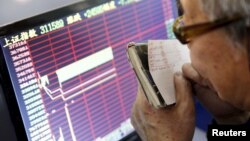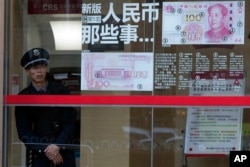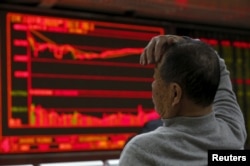China stopped trading on its stock market Thursday for the second time this week as share prices plunged and the value of the Chinese currency continued to depreciate. Analysts say the situation in both markets could worsen in the coming days.
Chinese stocks tumbled 7 percent, prompting the regulator to shut down the market to avoid a further slide. The yuan slipped after the People’s Bank of China pushed down its guidance rate 0.5 percent to 6.5646 per dollar, which is the weakest point since February 2011.
Analysts expressed concern about a possible currency war in the region. China’s neighbors might be tempted to join in competitive devaluation with each country trying to defend its exporters, said Oliver Rui, professor of finance and accounts at the China Europe International Business School in Shanghai.
“The government may be trying to encourage exporters and manage the weakening gross domestic product. But such a move can have a negative effect because neighboring countries will do the same thing and cause a currency war,” Rui said.
Regulator blamed
As the market fell and the stock exchanges closed, a large section of investors blamed the China Securities Regulatory Commission for coming up with strict circuit-breaker rules. The rules force the stock exchange to halt trading for 15 minutes if prices fall five percent, and later shut the market down for the entire day if the slide continues and reaches seven percent.
The rule is being cited by analysts as the trigger behind today’s market tumble. The regulator’s intention was to cool the market but it ended up causing panic among investors, said Johnny Fang, analyst with consulting firm Z-Ben Advisors.
“The effect on the market is opposite of what was expected. Investors regard the circuit breaker as an accelerator for the bear market,” Fang said.
The Shanghai market went into the 15-minute break after prices slid 5 percent soon after trading opened on Thursday. It took just one minute for the market to drop another two percent and hit the circuit breaker after it resumed trading.
Each investor was in a rush to be the first to sell before others hammered down the price, resulting in major losses, market observers said.
“The government should stop treating rational investors as naïve babies because its decisions cause uncertainty. The market does not need this kind of protection,” Rui remarked.
The regulator is unlikely to change the 7 percent circuit breaker rule because that would amount to admitting its mistake, Rui said. It has come out with another rule that disallows major investors more than one percent of outstanding stocks within three months.
“The one percent rule is worse. You cannot ask people not to sell stocks. It will only worsen the situation,” he said.
Rui also expressed his concern that the Shanghai exchange may be suspended once again tomorrow because investors are in a pessimistic mood. Besides the circuit breaker rule, which acted as an immediate trigger, there are three other reasons behind the market slide:
• Chinese stocks are still overvalued, and there is room for correction
• Negative signals coming from the world economy and poor showing of the Chinese economy
• Devaluation of the Yuan
Coming challenge
The regulator is faced with another challenge next week when it is due to open up locked shares for trading. Chinese rules prohibit a large number of so-called “non-tradable shares” from trading for lock-in period of one or two years.
Shares worth $16.48 billion are coming up for conversion to “tradable shares” status as the lock-in period is due to expire on Monday. Analysts are saying that infusion of more stocks will result in higher liquidity and a further hammering in prices.
“Unlocking the locked shares is bound to have a negative impact. Prices would fall again, and the markets would be forced to close down. I expect the authorities to come up with some solution to the problem,” Fang of Z-Ben Advisors said.
Some analysts also expect the government to postpone the opening of locked shares. But such a decision would only delay the problem and not solve it because they will have to be unlocked sooner or later, Rui said.










